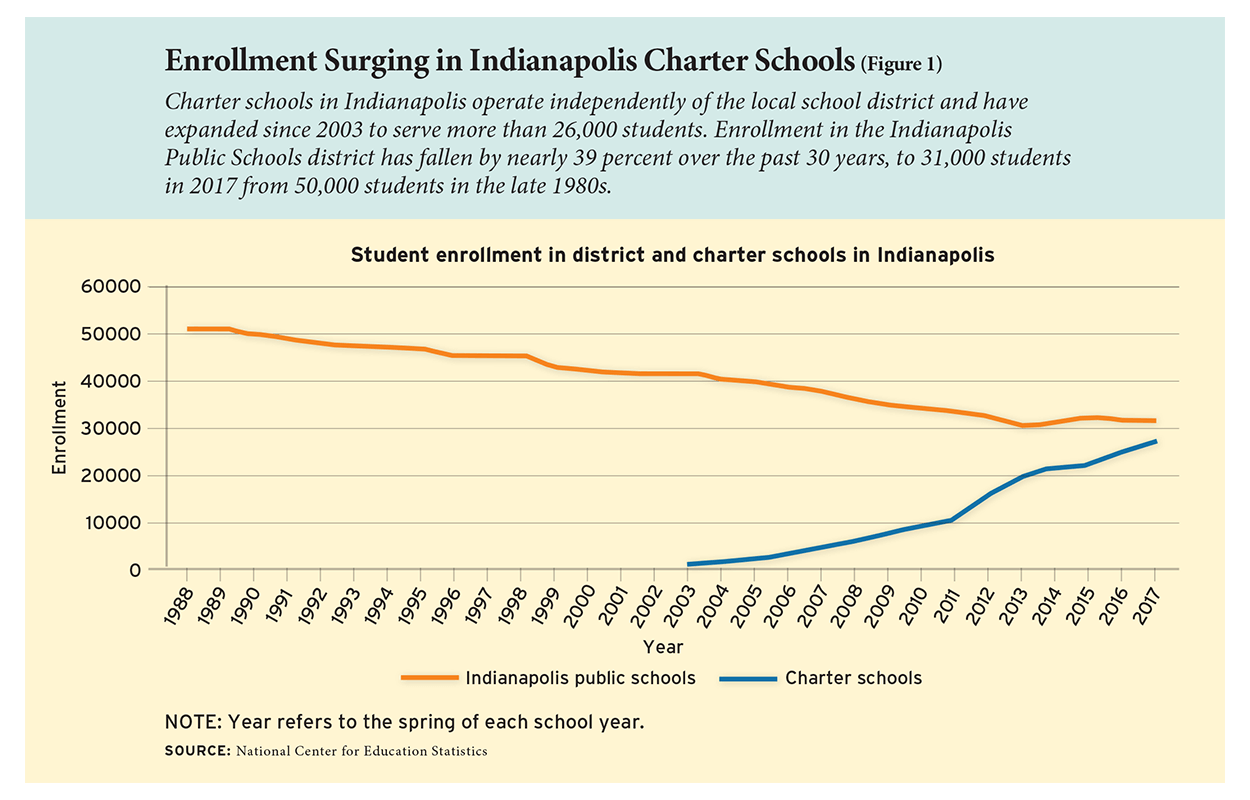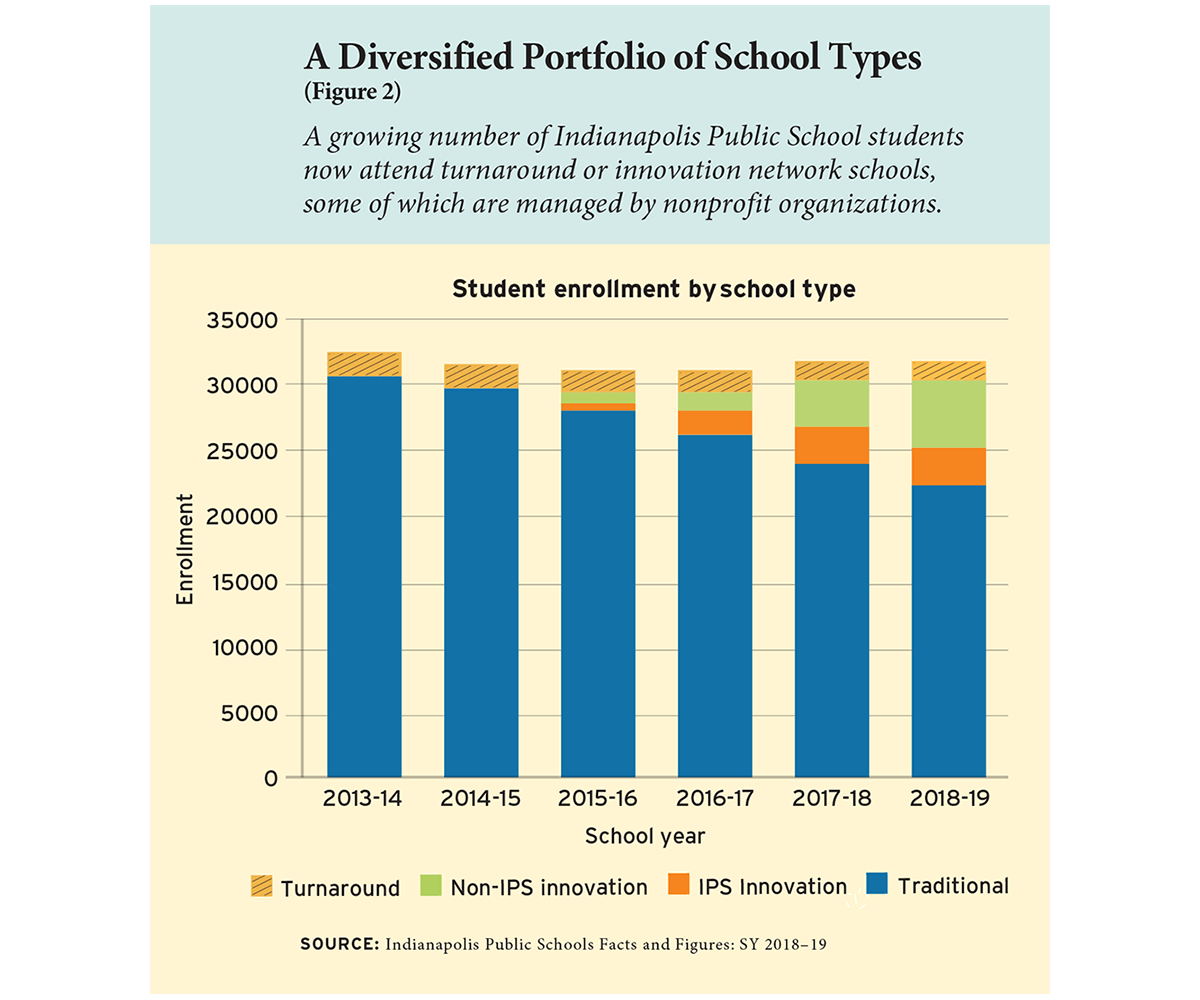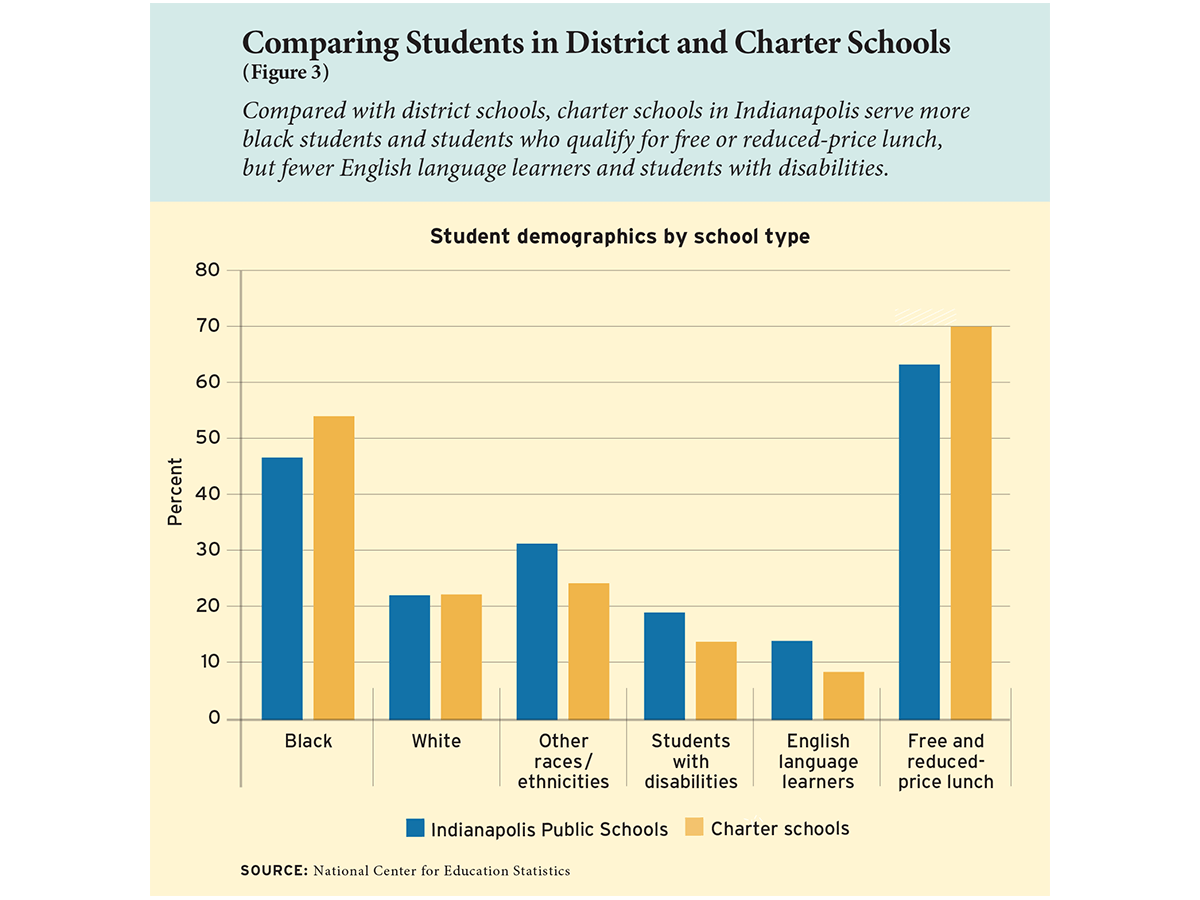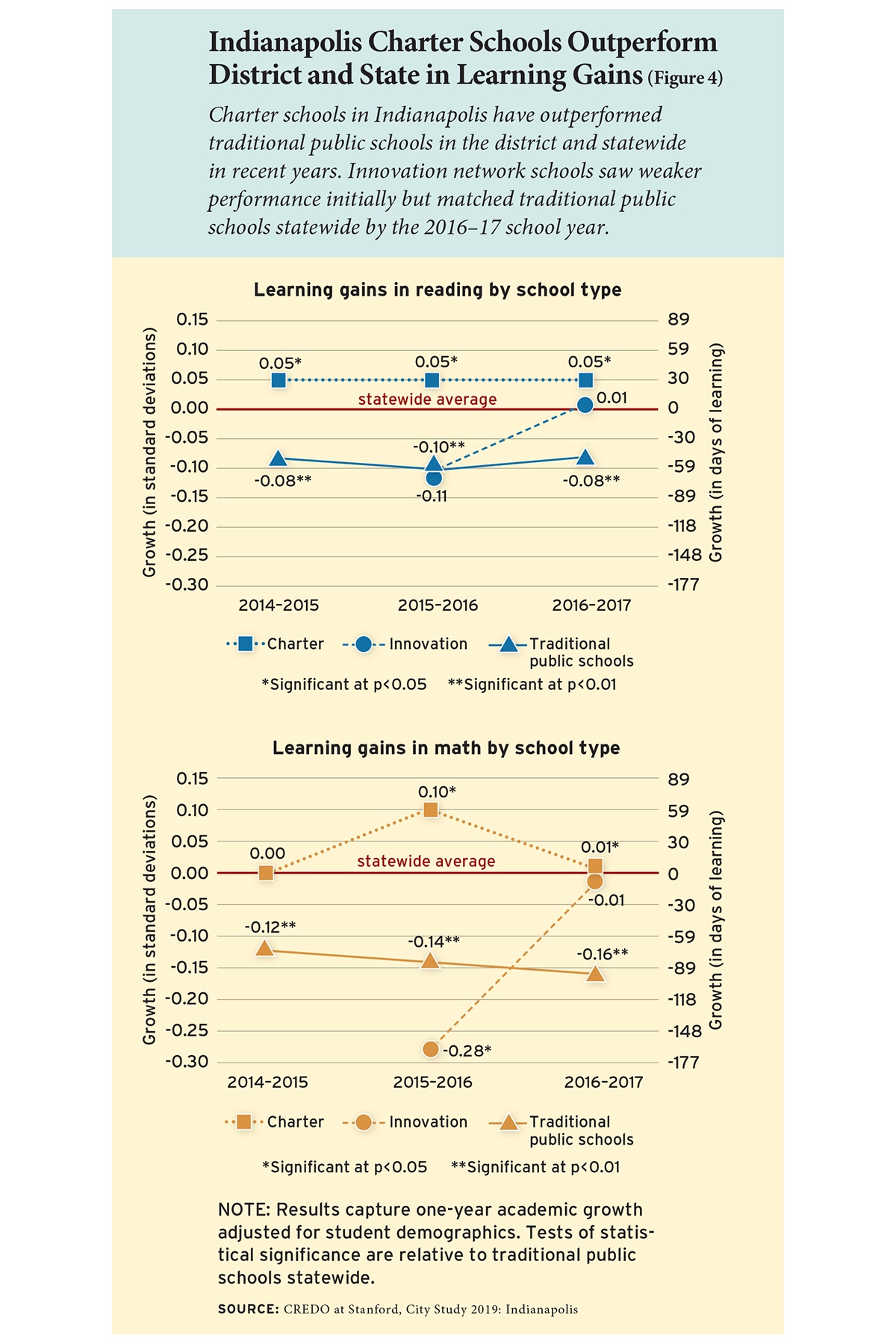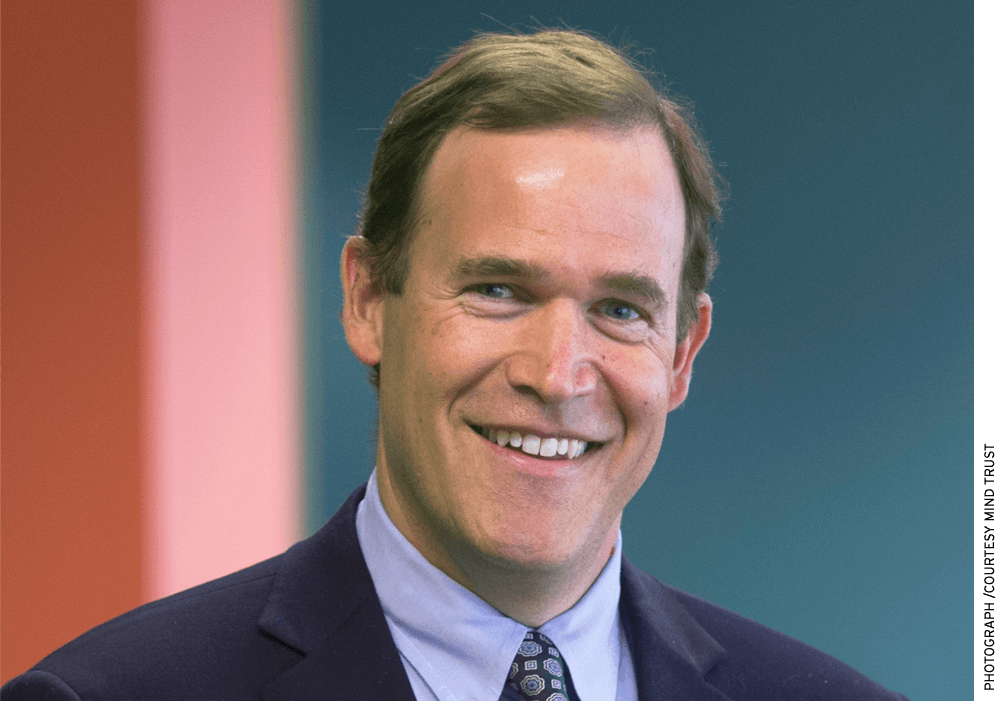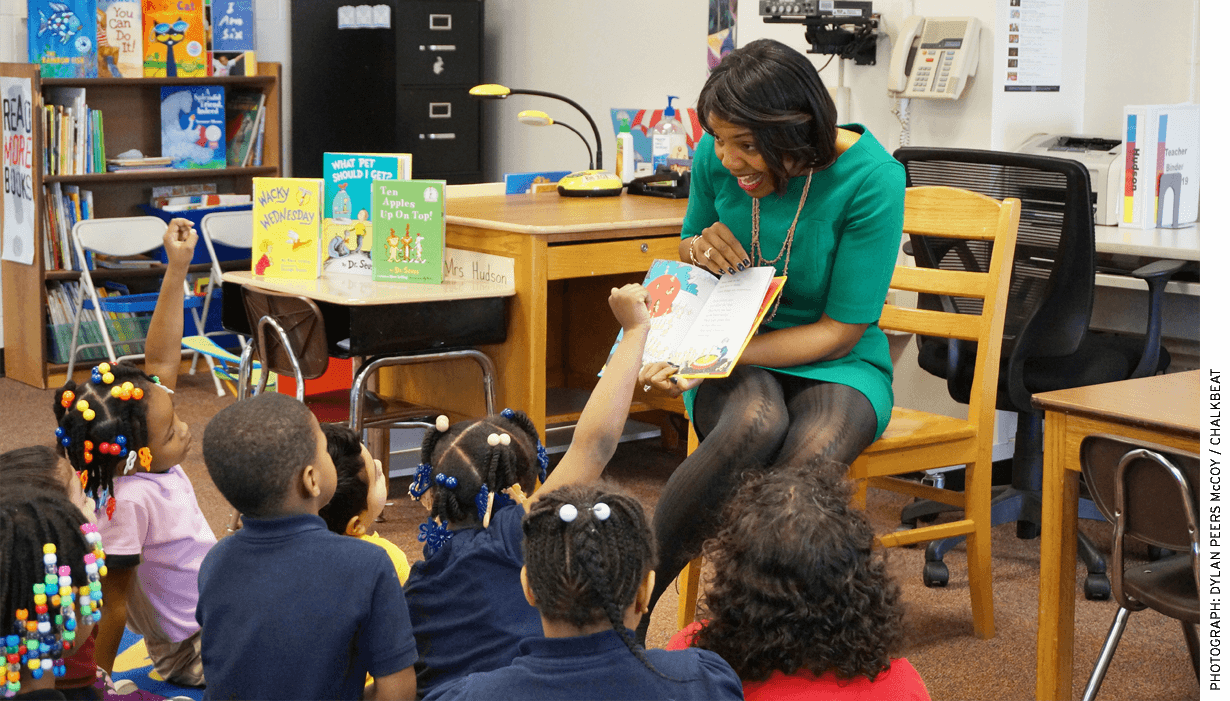
In the spring of 2015, Aleesia Johnson and Brandon Brown met for coffee. They both had new job offers.
Johnson was then a star principal at a local KIPP (Knowledge Is Power Program) charter school and had been asked by Lewis Ferebee, the new superintendent at Indianapolis Public Schools, to head up his innovation strategy. It was a critical role: the state legislature had just passed a law making it possible for school districts to partner with charter schools rather than fighting them. New hybrid schools, comprising an “innovation network,” would have the autonomy of charter schools but would operate in district buildings and serve neighborhood students, sometimes replacing the district’s schools that struggled the most. Ferebee had lobbied for the law and now wanted Johnson’s help to put it into action.
As for Brown, after three years of running Mayor Greg Ballard’s charter-school office, he’d been offered a job at The Mind Trust, an Indianapolis nonprofit focused on building school quality and access in the city. Ferebee and The Mind Trust’s then CEO David Harris had already struck a deal to work together on the innovation network schools idea.
If Johnson and Brown both took the jobs, they would be spending a lot of time together. Brown would be incubating the new schools that Johnson would oversee. Johnson remembers that they looked at each other that day and asked, “Are you gonna take the job?” “I don’t know. Are you gonna?”
Today, Johnson is superintendent of Indianapolis Public Schools and Brown is CEO of The Mind Trust. The city has 21 innovation schools serving one in four of its public-school students. Two new rigorous studies point to promising student-achievement gains. These autonomous district schools stand against a backdrop of a thriving public charter sector and a private-school voucher program that fill the gaps.
What made this all possible? Indianapolis is a story of good people, good politics, good local and state policy, and some small-town goodwill and good luck. The mayors led, state policy provided backbone, and civic leaders and philanthropies stepped up. They broke down institutional barriers in support of what most education-policy people will tell you is the unifying goal in the city: good choices for all families.
Mayors Lead the Way

In the late 1990s, Indianapolis faced a schooling crisis: the landlocked, post-industrial city suffered brain drain; as a result, its schools and students also suffered. There were 11 separate school districts and no citywide approach. (Since 1970, the metro area has had a consolidated city-and-county government that encompasses the city itself and 10 other Marion County communities that retain some autonomy but fall under the control of the Indianapolis government. More than 75 percent of Indianapolis Public Schools students are black, Hispanic, or multiracial, and about the same proportion qualify for free or reduced-price lunches. The other 10 communities are largely suburban in character and have more affluent populations.)
Bart Peterson, a Democratic candidate for mayor in 1999, saw education as a way to build consensus on economic development. People had been trying to fix the ailing public schools for a long time, and Peterson believed a catalyst from outside the system was needed.
At the time, Peterson says, education reform was a contentious issue. “People couldn’t sit in the same room with each other,” he remarks. He believed that charter schools could provide the common ground, since they offered independence to principals but were still fundamentally public schools.
Candidate Peterson hired a young lawyer named David Harris, who jumped in to craft an education agenda, reading up on charter schools and following developments in states like Minnesota, where Democrats were supporting innovation and experimentation with charter laws.
Peterson won, and in September 2000, he made his case for charters in a speech to Indianapolis-area school superintendents. The atmosphere in the room was tense, but Harris says that coming out early on this controversial issue allowed the administration to control the narrative: “After that speech, no article about charter schools was written without a quote from the mayor.”
State Policy
Republican legislators had tried to pass a charter bill for seven years but had been thwarted by a Democratic-controlled House. Republican state senator Teresa Lubbers, the bill’s main champion, says she thought hard about the details of the bill, such as who would authorize charters and how schools would be held accountable: “I never thought it should be easy to start a charter school,” says Lubbers, now Indiana’s commissioner for higher education. “It should be hard, because there had to be a compelling reason why, for the students’ sake. It was an experiment, after all.”
A provision in the law would empower mayors to authorize charter schools in their cities; the mayor of Indianapolis subsequently became the first such official in the country with that authority. Peterson’s backing of charters and his willingness to play a central role as an authorizer proved important to winning Democratic support for the bill.
Advocates also won key Democratic votes when Republicans agreed to rescind a mid-1990s law limiting collective-bargaining rights in the school system, a measure that had been backed by then mayor Stephen Goldsmith.
The charter school bill passed the Senate in April 2001 and was signed into law by Governor Frank O’Bannon, a Democrat and charter school supporter. Determined to create as many reform tools as possible, the state kept up the pressure. Over the next decade, under Governor Mitch Daniels and state schools chief Tony Bennett, state legislators passed a whole package of reform bills: launching a voucher initiative, expanding charters and giving them rights to unused district buildings, allowing virtual charters, and overhauling teacher accountability. A public-school-choice law allowed students to move from district to district and forced districts to start marketing and fighting to keep their students. According to the House education committee chair, Bob Behning, the state’s early commitment to providing student aid for its 30 private universities further helped establish choice as a normal way of operating.
State representative Todd Huston (at the time, Tony Bennett’s chief of staff) credits Governor Daniels for bringing state officials together around the charter school policy: “A lot of it was Mitch,” he says. “None of this works if you don’t have a committed governor.”

Innovation Network Schools
Huston was a key figure in the passage of several bills, including the innovation network schools bill that would eventually transform the Indianapolis schools. A former school-board member, he understood the challenges involved in transforming school systems. Like many Hoosier education reformers, he had read about, and was inspired by, Milwaukee’s education reforms.
During the first dozen years of the new millennium, competition from inter-district choice and charter schools, along with the threat of state takeover of poorly performing schools, created an urgent sense that change was needed in the Indianapolis Public Schools.
Mayor Peterson’s early commitment to charter schooling held fast throughout his two terms in office. David Harris, his aide-de-camp, created one of the nation’s leading authorizing offices. Bucking national trends, Harris’s office drew on outside expertise to help develop a stringent review-and-oversight process for mayor-sponsored schools. Peterson was actively involved. Harris recalls late-night meetings with the mayor to decide specific performance metrics to use for accountability, for example. Before long, Harris saw the need to create a strong pipeline of charter operators by recruiting new talent to Indy and incubating new schools. In 2006 Harris left the mayor’s office and created The Mind Trust ( see sidebar).
In 2007, Bart Peterson lost his reelection bid to Republican Greg Ballard in a major upset. A retired Marine Corps lieutenant colonel and plainspoken former businessman, Ballard took office in January 2008. Unexpectedly to some, Ballard chose not only to stay the course on his predecessor’s charter-school strategy but to take it further. In 2012, during his second term, he recruited a young Teach for America alumnus named Jason Kloth to serve as deputy mayor of education, and elevated the charter office to the Office of Education Innovation. It didn’t take long for Kloth to see that educational improvement in Indianapolis would require more than just an outside push.
At the time, the school system was caught in a downward spiral, with enrollment having fallen to about 30,000 students in the mid-2000s from more than 100,000 in 1969. This drastic drop resulted from a combination of factors: students enrolling in neighboring-city school districts, the rapid expansion of charter schools, and the city’s changing demographics (see Figure 1).
The city’s school superintendent at the time, Eugene White, had little credibility with state policymakers, and state superintendent Bennett was threatening to take over the city’s low-performing schools under the authority of a law passed in 2000.
In response to a request from Bennett, The Mind Trust put out a report in December 2011 calling for the elimination of elected school boards and the empowerment of educators at the local level. Though controversial, this “Opportunity Schools” plan laid out a vision for transforming the city’s schools and paved the way for the innovation schools law. At the same time, Stand for Children, an education advocacy nonprofit, was raising money to get reform-friendly school-board members elected, and much of the public debate centered on The Mind Trust’s proposal. Over the next two years, 2012 through 2014, a series of events would set a bold new district strategy in motion. A new board was elected in 2012 (the same year Mike Pence became governor) and the board quickly recruited a young new superintendent, Lewis Ferebee, to start in September 2013.
A Civic Triangle
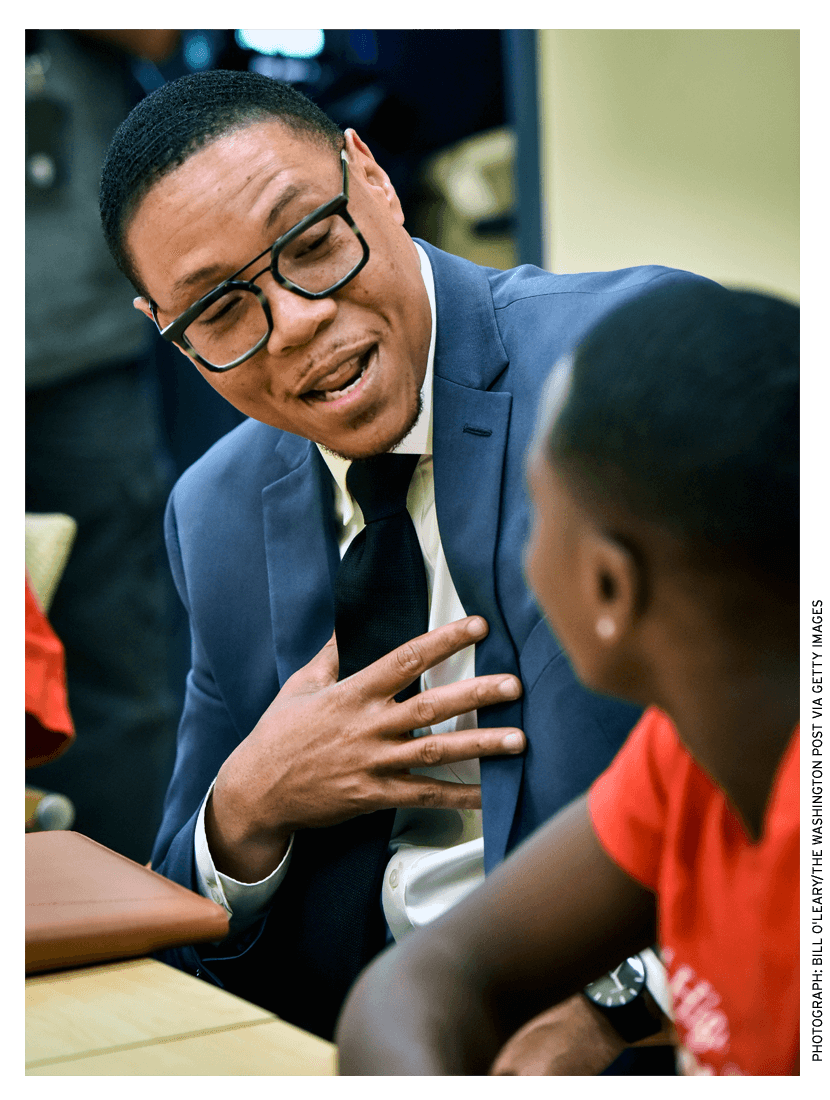
Ferebee was unknown on the national scene and had never run a school system before. He had served as a school principal at Guilford County Schools in North Carolina and then as chief of staff at Durham Public Schools, where he led a successful school-turnaround effort. Ferebee came to Indy with an open mind and no preconceived change agenda.
Jason Kloth in the mayor’s office approached Ferebee with an idea to present to the state. Informed by The Mind Trust’s Opportunity Schools report and the experience of other cities with district-charter collaboration, Kloth had been developing a plan that could help the Indianapolis school system transform itself while also enabling local charter schools to become more sustainable. Charter market share exceeded 30 percent, but growth had stalled, primarily because of lack of access to facilities. Community members saw The Mind Trust as closely aligned with charters and antagonistic to the district. The narrative had to shift.
The Mind Trust brought school-board members and local civic leaders to New Orleans, which was implementing the portfolio model—characterized by broad school choice for families (based on a “portfolio” of charter and district-run schools), plus autonomy paired with accountability for educators. The Indianapolis leaders hoped to apply the concepts of school-level innovation and empowerment to create an approach tailored to Indiana.
Kloth and his colleagues developed a legislative proposal to give district schools full charter-like authority as called for in The Mind Trust report. Governor Pence liked it. Key legislators liked it. So did a politically diverse civic organization called the Lewis-Hubbard Group, which had originally convened to develop citywide facilities recommendations. While the idea came from Kloth in the mayor’s office and The Mind Trust, the mayor’s staff worked through the statehouse and with the school system, and Ferebee took the lead. “It was very powerful to have the superintendent lobbying for it,” Ballard says.
Ferebee, Harris, and Kloth formed what one observer called a civic triangle to focus on creating high-performing schools. They were acting out of an immense urgency to avoid state takeover: charter growth showed signs of slowing, the school board was looking for a strategy, and the community was calling out for change. Innovation network schools held promise for addressing this predicament.
A Pivotal Decision
Despite growing support for the innovation schools proposal, getting the bill passed in the legislature was no slam-dunk. Civic activists were still angry and mistrustful over The Mind Trust’s Opportunity Schools report, and the teachers union was strongly opposed: innovation schools would operate outside of the union contract. Even Indiana’s committed choice advocates weren’t a sure bet for support, as many were wary of attempts to bring charter schools under the district umbrella.
By all accounts, Ferebee’s backing made all the difference in the bill’s passage. He asked that its name be changed to align with a district initiative he had underway (originally the bill was called the Freedom to Teach Act), but otherwise he ran with it, meeting with legislators and local opponents and explaining how autonomy could improve district schools. He was only months into his new job.
“Ferebee wants what’s best for kids,” says Ken Britt, dean of Marian University, calling him “the quintessential gentleman.” “He’s gone on the record saying, ‘If we can’t serve this child well, what gives us the right to keep a child in a failing school?’ He put courage and political capital on the line.”
The Innovation Network Schools bill passed in the spring of 2014. Shortly thereafter, Ferebee and Harris agreed to work together to create a strong supply of new innovation schools through The Mind Trust. Philanthropies supported innovation network fellows. Brandon Brown from Mayor Ballard’s office was recruited to take on an important challenge: create a new function at The Mind Trust, working with the school system and developing school models that could succeed in the district context.
Ferebee knew he’d need someone to help him oversee the innovation schools program and rejigger his central office to fully support autonomous schools. He met a highly capable young KIPP principal who might fit the bill: Aleesia Johnson came onboard and handled the technical and political challenges of launching the new-schools initiative while also managing the internal dynamics and turf issues in the central office. One of her early decisions helped smooth the challenges of implementation. The law gave the district a turnaround strategy by allowing it to replace low-performing schools with charters. Johnson decided, however, to expand the initiative by also inviting good district schools to apply for innovation status, thereby giving effective district educators the same freedom and autonomy that charters enjoyed. This approach created a natural internal constituency for the innovation schools program and ensured that the “brand” would include high-performing district schools, not just new charter schools.
Mariama Shaheed Carson, a local teacher and principal, was one of the first to open an innovation network school. She had tried to start her dream dual-language charter school—the Global Preparatory Academy—in another Indianapolis district but was turned down. She applied for The Mind Trust fellowship and opened her school in partnership with the Indianapolis schools. Shaheed Carson’s school brought early credibility to the program and helped spur interest from other local educators. The Mind Trust and Stand for Children informed families about the law in a series of community forums that helped build grassroots political support.

New Life for New Schools
Nationally, many charter leaders dismiss the concept of district-charter collaboration as a waste of time. If charters can be successful on their own, some have argued, why not just invest in their continued expansion? Indianapolis shows why such collaborations, when done thoughtfully, can be a win for charters, for districts, and, most importantly, for families.
Without the Innovation Network Schools law, Indianapolis charter-school expansion might well have hit a wall. Growth was likely to slow as The Mind Trust struggled to find and finance new buildings for charter school operators in the city. And if other cities are predictive, public perception might have eroded to the point where people started to blame district financial woes on charter schools. The Innovation Network Schools law has allowed the city to tap a new pool of innovators and has enabled charters to get greater access to district-owned buildings by taking over the operation of low-performing schools.
At the same time, the schools brought a new level of credibility to education reform in Indy and blunted political pushback. David Harris, initially skeptical about collaboration with the district, notes, “Educators are often upset about the innovation schools but then meet the leaders and see they are credible and have a long history in IPS. Importantly, successful schools have converted to innovation status, choosing autonomy over union protections, and are some of the strongest advocates for the law.”
Aleesia Johnson took over as superintendent after Ferebee left in December 2018 to run the Washington, D.C., public schools. As a former charter-school leader, Johnson saw autonomy as an enabler for great educators. In order to spur innovation, she reasoned, the district needed to free those educators; it also needed to find ways to reset toxic dynamics in chronically low-performing schools. Today, one out of four Indianapolis public-school students is enrolled in an innovation school (see Figure 2), but Johnson does not have a prescribed vision for how many such schools will eventually open. She plans to leave it up to educators to ask for the conditions to innovate and will force those conditions only when low performance demands it. In that way, she reasons, the innovation schools will continue to be what educators want, not what they fear.
Gains in Student Learning
More than a third of all public-school students in Indianapolis now attend a charter school, and the vast majority of the charters are authorized and overseen by the mayor’s office. The Indiana Charter School Board oversees the rest. Twenty-one public schools operate as innovation network schools.
Compared to district-run schools across Indiana, Indianapolis charter schools serve a student population with more challenging academic needs, more students who identify as members of a racial minority, and fewer students for whom English is a second language or who qualify for special education and an Individualized Education Plan. These same trends hold at the local level (see Figure 3).
Promising new results from Stanford University’s Center for Research on Education Outcomes, known as CREDO, show that in 2016–17, both charter schools and the new innovation network schools in Indianapolis had stronger reading and math gains than the city’s traditionally run schools (see Figure 4). The results were especially strong for black, Hispanic, low-income, and English language learner students. Compared to state averages, the results show more variation, with both innovation network schools and traditional public schools in the district showing weaker growth in math. The study, released in January 2019, compares each student’s gain to gains of similar students in district schools.
Another study conducted by researchers at Indiana University and released the same week as the CREDO study looked at elementary-school students who enrolled and stayed in Indianapolis charter schools sponsored by the mayor and found they outperformed their peers in all 11 Indianapolis school districts.
While Superintendent Johnson is pleased with the improvements in student performance, she cautions that early growth is to be expected in the innovation schools, given how low the scores were at baseline. She is looking to see sustained growth over time. She also notes that because the innovation schools label includes so many types of schools with different starting points and contexts, the trajectories of individual schools will provide more meaningful data than will performance averages.
Lessons Learned
The unique civic dynamics in Indy and the state of Indiana help explain why education reform in the city has been less contentious and more pragmatic than in many other places. Indianapolis is a small city where people know and like each other. Individuals may move to different organizations, but they stay committed to the mission. And then there is the “Hoosier Way,” a general belief that people should treat each other with respect and kindness.
Against this backdrop, leaders took a number of intentional steps to build and sustain political and technical supports for the expansion of choice. Some of the most important were:
Building trust and credibility. Several key charter advocates made it clear early on that expanding choice was not enough: quality was also paramount. The authorizer role was to establish and enforce clear quality standards. The Mind Trust’s role was to create the conditions that would ensure an ample number and variety of school options for families.
Focusing on quality and local authorizing would be best for students, these leaders believed, but it would also help build credibility. In the early days, nasty politics abounded. Superintendents were adamantly opposed to the mayor authorizing charters, but quality helped blunt their arguments.
Jason Kloth says many people initially thought there was a secret plan to take over the school district. But when the state, the school board, and the superintendent agreed to champion the Innovation Network Schools law, “we built trust and credibility,” he says. “It was the way we approached it: It wasn’t ‘let a thousand flowers bloom.’ Quality really mattered. People couldn’t say that we had a huge portfolio of mixed quality and were trying to blow things up. Credibility breeds trust. Quality builds trust.”
Continuity of smart and brave leadership. Leaders and advocates at every level strongly agree on what has driven progress in Indianapolis and what’s needed to move forward. A key factor in effecting change in the schools was the fact that four successive mayors, Democratic and Republican, maintained the same strategy over nearly two decades. And David Harris has been a constant throughout.
Peterson and Ballard credit Stephen Goldsmith, Peterson’s predecessor, with establishing a strong link between education and economic development in the city.
Peterson believed that charter schools “had the potential to save urban education,” he says. “My support was solely for policy reasons, not political, but it did not hurt me politically. In fact, it helped me.” Democrats denounced him on the policy but agreed with him on everything else, so it “didn’t hurt me with Democrats, and I won the support of reform-minded Republicans.”
When Ballard took the helm, he pushed the choice initiative forward and now cites the mayor’s office as modeling “the gold standard” for quality authorizing. “Less than 25 percent of those who apply get approved,” he notes.
As superintendent, Ferebee was, by all accounts, artful in building good relationships and inviting opponents to the table. Early in his tenure, he took time to look closely at the district budget; he found pots of money that he was able to repurpose toward supporting the innovation schools. This bought him a lot of goodwill among teachers and likely helped him keep innovation schools under the radar.
Local and national investments. Indianapolis, though small, has attracted significant local and national philanthropy over the years. The combined investments, estimated to be in the hundreds of millions of dollars, have supported talent recruitment, school incubation, community engagement, technical assistance for the district’s central-office transformation, and political advocacy for key policies.
Not long after the charter law passed in 2001, the Richard M. Fairbanks Foundation, an Indianapolis-based philanthropy, supported a “lead and seed” initiative to try to attract national charter-management organizations to the city. When the national organizations declined to come, the foundation shifted toward seed funding to start The Mind Trust and help the city grow its own charter schools. Also stepping in with support were the Lilly Endowment, the Casey Family Foundation, the Laura and John Arnold Foundation, and the Walton Family Foundation.
Highly cultivated, aligned supports. Through The Mind Trust, the city invested early on in talent and school incubation and other citywide supports, sparking rapid growth in charters and innovation schools. The Innovation Network Schools law allowed the city to “build a partnership that is advantageous for both district and charters,” in the words of Representative Huston, “but it doesn’t work without The Mind Trust.” Teach for America provided an essential talent pool, and that organization’s alumni now run half of the city’s innovation schools.
Unified front on choice. Over the years, Indiana policymakers and advocates have not gotten hung up over which kind of choice or regulation is “best.” Whether they prefer inter-district choice, charter schools, tax credit scholarships, vouchers, or innovation network schools, they have not let specific ideology undermine each other’s efforts. The overarching goal of “good choices for all” is the unifying mantra in Indy, and reform is not seen as a zero-sum game.
Commissioner Lubbers, who originated the state charter law, says it was more than a sense of civility and the “Hoosier Way” that created such harmony. Advocates for change also shared a true commitment to the power of choice. “There was the potential for charters and vouchers to be adversarial,” she says. “That didn’t really happen. People were brought together by the sense that students were being left behind.”
Civic leaders stepped up. The idea that a strong education sector is central to a vibrant city has motivated local leaders to push for change in Indy schools. As noted above, bipartisan mayoral leadership has been critical to effecting education reform—and right behind the mayors stood the city’s most-respected business, civic, and education leaders. The Mind Trust board includes some of the most influential people in the city, who backed Ferebee and helped him make his case for innovation network schools to the community. Civic advocacy was key in putting forth the mayors’ priorities.
State pressure and cover. A series of important state policy moves over the last two decades paved the way for a third-way approach in Indianapolis. In 2011, when the city schools were under the greatest threat of state takeover, new legislation created the voucher program and enabled charter school expansion. The year ended with The Mind Trust’s controversial report, and the groundwork was laid for the 2012 school-board elections. With the passage of the Innovation Network Schools law in 2014, leaders like Ferebee, an educator and a “gentleman” with no stake in the warring ideological camps, could pursue a new strategy.
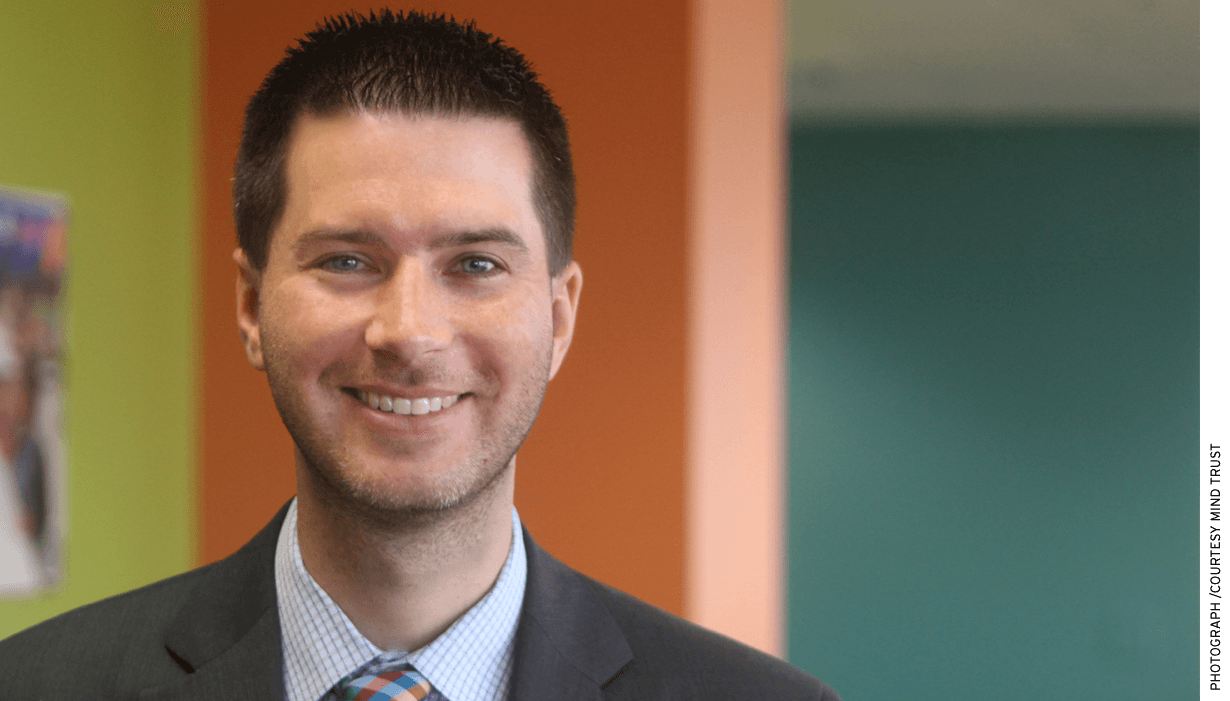
Missteps and Challenges
Deep community engagement came late. The key actors in this story can be described as elites—and many of them are white men. It was not until recently that a more representative set of actors came to support reform and get deeply involved in these efforts. Inattention to community engagement was, by all accounts, The Mind Trust’s greatest misstep. It wasn’t until after the Opportunity Schools report that the organization invested in meaningful community engagement. Despite support from local newspapers’ editorial boards, the black community recoiled and many people saw The Mind Trust as a group of elitists writing plans to take over the local schools. According to Brandon Brown, “We needed to engage with people on the front end and build more internal team capacity for that engagement. You can’t ignore the community. Plans can’t exist in a vacuum.”
In 2013, The Mind Trust hired Kameelah Shaheed-Diallo to change its approach to community engagement, finding ways to more effectively listen to people and respond to their concerns. Shaheed-Diallo led many dozens of difficult meetings with opponents of The Mind Trust’s Opportunity Schools plan. David Harris says it was a challenging but critical process. Following nearly two years of targeted engagement, black leaders showed public support for the innovation network schools plan by attending the public event announcing the first participating schools.
Blind eye to existing talent, district leadership. For years, Indy education-reform advocates dismissed the idea of partnering with the Indianapolis school system, viewing it as hostile and defensive toward charter competition. But The Mind Trust leaders now see that they were naive to believe they could import all the talent needed to improve the city’s schools. They also realize now that they couldn’t expect charters to grow indefinitely without working with the district to tackle the barriers to such growth. Investing in district change strategies and relationship building proved necessary.
To be sure, the collaboration has hit some snags. Some schools complain of transportation logistics problems and other issues. But talented district educators who once lacked autonomy now have an avenue to start their dream schools, and the charter sector is reinvigorated. The Mind Trust has learned that investing in local talent pays off in many ways. Says Brown, “Once respected leaders experience the benefits of autonomy, they have conversations with their colleagues, which leads to more opportunities.” Seventy percent of The Mind Trust’s innovation network schools fellows are leaders of color, reflecting the city’s demographics and thus contributing to more community goodwill.
Inattention to special education and other supports. Indianapolis charter schools, which must provide their own special-education services, have sometimes struggled to meet the needs of all students. Some people allege that charter schools have “counseled out” students and, more broadly, that their lack of capacity simply causes families of children with disabilities not to consider them as viable options. About 14 percent of those enrolled in Indy charter schools are students with special needs, compared to 18 percent in the Indianapolis Public Schools. Too many charter schools in the city are good enough to be renewed but lack incentive and knowledge to continue to innovate for instructional improvements. Under the leadership of Brown and others, this is changing: a new special-education collaborative effort is underway to allow innovation network schools to access the district’s special-education services. The Mind Trust now provides curriculum audits to help schools identify gaps in instructional rigor. Still, these are both nascent efforts, and other citywide challenges loom for the increasingly decentralized school system, including transportation and facilities access.
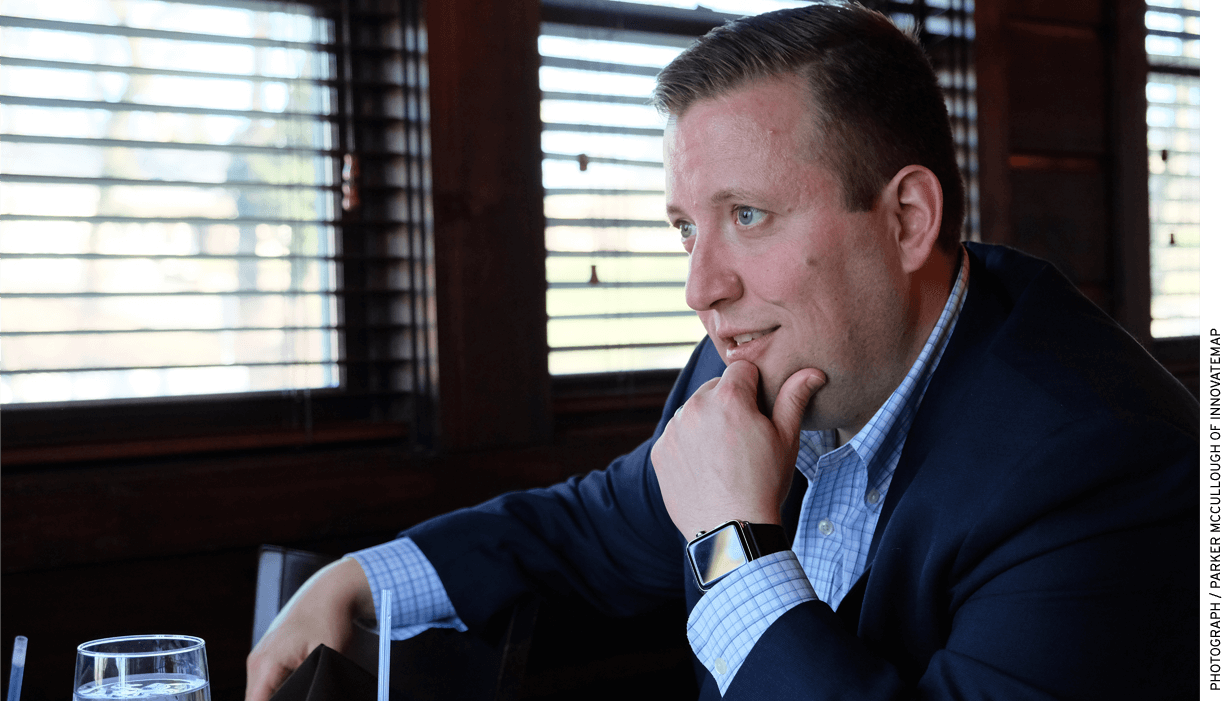
The Work Ahead
Study results on innovation network schools prompt many in the city to say: “We’re doing well, but not well enough.” Continued sustained progress is the goal, but it is not assured. Reform advocates still hold a majority on the school board, but it is narrower than in 2012. Superintendent Johnson and her team must complete the difficult work of transforming central-office practices to support autonomous schools while also providing strong supports for the schools they manage directly. Schools that have made initial gains by improving their academic quality now must turn to tougher challenges that impede students’ learning, such as trauma, poverty, and opioid addiction. Marian University recently revamped its teachers’ college to focus on content experts, in-school training residencies for teachers, and more diversity to further fuel school improvement in the city; the need for this kind of retooling and rethinking will persist.
New statewide and local pressure on the schools to increase their focus on career pathways creates opportunities to help education leaders reimagine and rethink everything, but it also runs the risk of reinforcing tracking. Higher education commissioner Teresa Lubbers says, “We need to move students to where they want and need to be to have a meaningful life, within an economy that’s transforming all the time,” with many jobs changing and some being eliminated.
A $272 million tax referendum, led by Ferebee and backed by the Urban League and other civic organizations, passed in November 2018; the new funding will pay for teacher raises and capital improvements. (Some believe that the reformers’ decision to back the referendum rather than invest in board elections was a mistake and a reason that more union-backed school-board candidates won than were expected.)
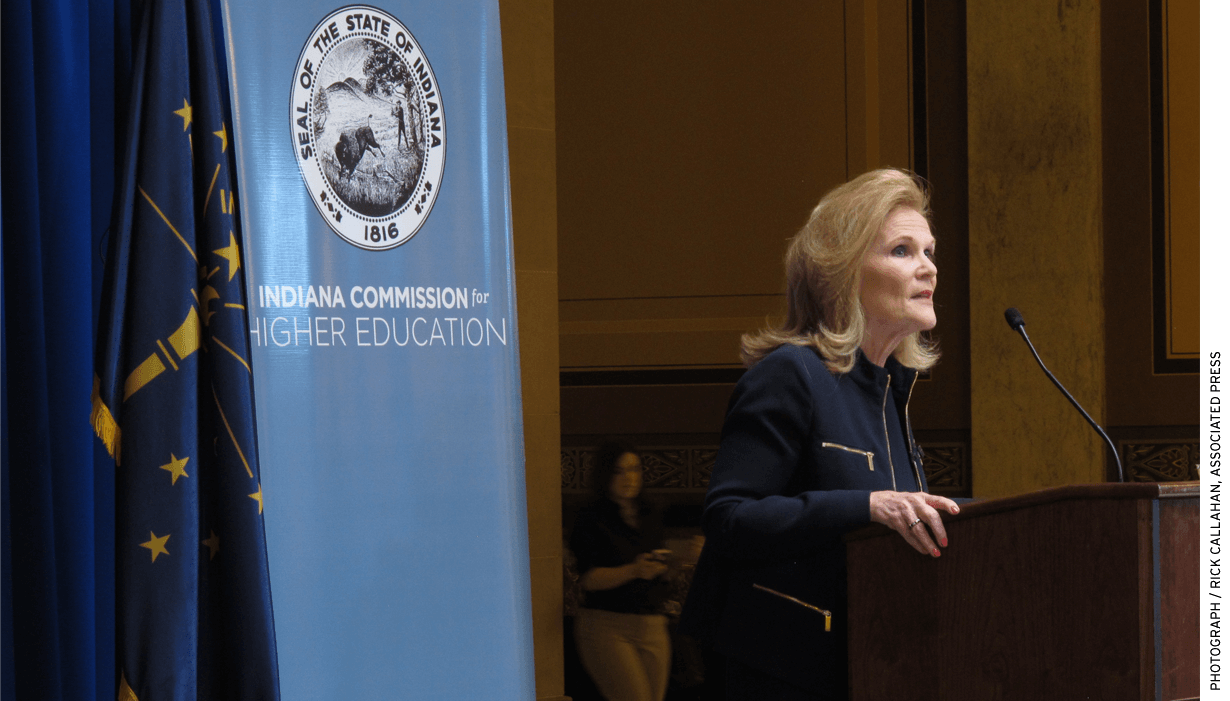
Many state and local leaders are concerned that none of the other 10 school districts in metro Indianapolis have taken advantage of the Innovation Network Schools law. The state finance system allocates education dollars on a per-pupil basis, taking into account student-need factors such as poverty. As a result, school operators are more interested in opening in the city’s downtown core, where the money is, than in the outskirts. The policy is meant to concentrate funding in areas that most need new options, but students in the other districts have their own unmet needs. Poverty is increasingly shifting to the surrounding districts as the city revitalizes, and some wonder whether the changing demographics will eventually lead to a change in funding and more new schools opening in the other districts.
As the school system and its schools continue to evolve, so too must their supporting institutions. The Mind Trust has demonstrated its ability to do this by backing new designs for turnaround schools and others. By all accounts, the quality of incubation keeps getting better, but new challenges lie ahead as the organization tries to figure out how best to further school improvement without imposing on school autonomy and parent preferences. Momentum for attention to career-relevant learning and solutions for students with unique needs may give rise to new constituencies and new school designs.
Amar Patel, head of Teach for America Indianapolis, would like to see an organization like the University of Chicago Consortium on School Research provide third-party analysis by drilling down on the data and learning what’s working. He also notes that despite all the investment, the talent requirements in the Indianapolis schools are still “a bottomless pit.” Patel says Teach for America could place four to five times more people in the pipeline than they currently have.
State politics have shifted under the new state schools chief, Jennifer McCormick, who is perceived as hostile to reform. (McCormick will complete her term in December 2020 and will be Indiana’s last elected superintendent; beginning in 2021, the position will be appointed by the governor.) Without the aligned efforts of the governor and state superintendent, local reformers are counting on continued commitment from the legislature. Still, the success of reform efforts in the city to date demonstrates that strong local leadership is also an essential element for change.
Local politics are fragile, and school-board dynamics could create more hostility to reform. The mayor is up for reelection in a year. Aleesia Johnson believes this is a natural inflection point for Indianapolis. The mayors and the state set the conditions, she says, but now it is up to the community to make the most of it. Brandon Brown agrees: “How do you move from community engagement to community empowerment?” he asks.
The common refrain in Indianapolis is that the reform efforts to date have set important conditions but will not be enough to achieve excellence. Sustaining progress for students will require continued commitment from adults, says Jason Kloth. “We have the best public policy framework in the country. We are one of the best capitalized with local philanthropy. We have all of the institutions in place that people think are needed. . . . It took a long time to get people aligned. Now we need to genuinely and authentically implement.”
Robin Lake is director of the Center on Reinventing Public Education at University of Washington Bothell. Shannon Murtagh, Erik Luk, and Roohi Sharma contributed analysis and data to this article.
This article appeared in the Spring 2020 issue of Education Next. Suggested citation format:
Lake, R. (2020). The Hoosier Way: Good choices for all in Indianapolis. Education Next, 20(2), 26-38.


